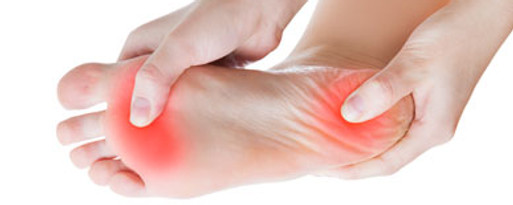Heel Pain


Heel pain is a common occurrence. In most cases the pain is caused by some form of mechanical injury resulting from small repetitive injuries that occur at a rate faster than the body can heal them.
Heel pain can also be caused by lower back problems or inflammatory joint conditions.
The following are types of heel pain:
Plantar fasciitis (or fasciopathy):
This is the most common form of heel pain, caused by damage to the fascia ‘band’ (similar to a ligament) which connects the heel bone to the base of the toes. This condition can be caused in various ways including extensive running, walking or standing for long periods of time, especially when you have a sedentary lifestyle. In particular, a change of surface (eg road to track), poor shoe support, being overweight, overuse or sudden stretching of your sole, as well as a tight Achilles tendon, can lead to this condition.
Heel bursitis (subcalcaneal bursitis):
This is an inflammation of a bursa (a fluid-filled fibrous sac) under the heel bone where the pain is typically more in the centre of the heel than that experienced with plantar fasciitis and significantly worsens during the day. This condition can be caused by a fall from a height on to the heel.
Heel bumps:
These are firm bumps on the back of the heel, usually caused by excessive shoe rubbing in the heel area, or the thickening of the tissues associated with a tight Achilles tendon.
Tarsal tunnel syndrome:
This can feel like a burning or tingling sensation under the heel within the arch of the foot with occasional loss of sensation on the bottom of the foot. This is caused by compression of the tibial nerve as it passes the inside of the ankle. Tapping of the nerve just behind the ankle bone (known as Tinel’s test) will stimulate the symptoms of the condition.
Chronic inflammation of the heel pad:
This is caused by a heavy heel strike or sometimes a reduction in the thickness of the heel pad which can give rise to a dull ache in the heel which increases during the day.
Fracture:
A fracture can be caused by falling from a height or landing on an uneven surface.
Sever's disease (calcaneal apophysitis):
This painful condition affects young children, usually between the ages of 8 and 12, especially those who are physically active or undergoing a growth spurt. It results from inflammation of the Achilles tendon where it attaches to the heel.
Achilles tendonosis:
This condition occurs when the Achilles tendon is placed under more pressure than it can cope with and small tears develop, along with inflammation, which in some cases leads to tendon rupture. These tears become a source of further injury, which can lead to swelling within the tendon, hence the name ‘tendonosis’ (sometimes referred to in error as ‘tendonitis’).
If you experience heel pain, some simple self-care measures include:
-
Avoid wearing ill-fitting or uncomfortable shoes
-
Wear shoes with good heel cushioning and effective arch support
-
Minimise walking or exercising on hard ground
-
Rest regularly and try not to walk or run too fast
-
Wear a raised heel (no more than 6-10 mm higher than normal)
-
Lose weight if you are overweight
How we can help:
-
we offer a comprehensive biomechanical assessment Individual treatmentplan a
-
treatment may include ading and strapping is applied to alter the direction of stretch of the ligament to alleviate symptoms in the short term.
-
long term, special insoles (orthoses) may be prescribed to help the feet to function more effectively and to make any possible recurrence less likely.
-
prescribe an individual rehabilitation excercise plan .
-
provide therapeutic laser treatment to reduce inflammation.
.png)